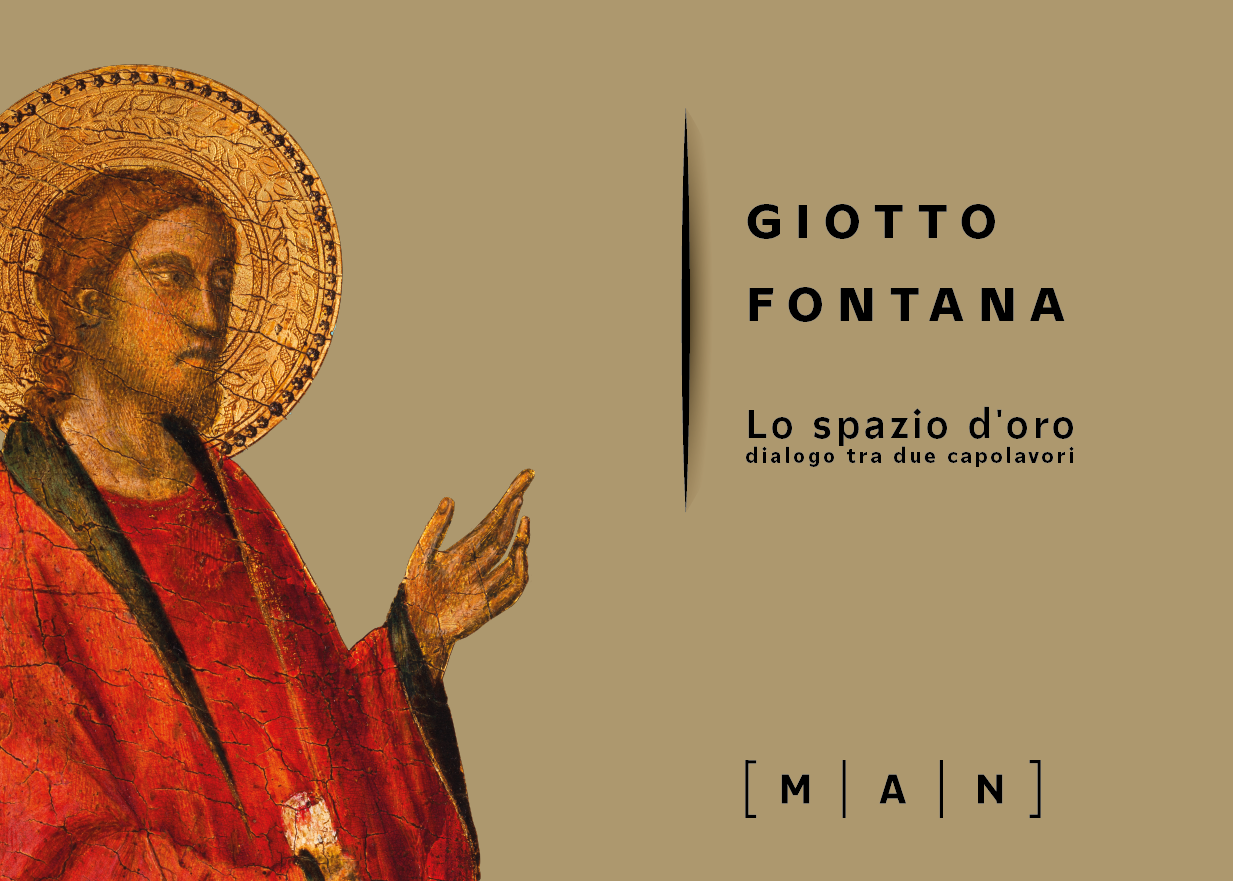a MAN production, Nuoro
from an idea by Chiara Gatti
scientific texts edited by Andrea Nante and Paolo Campiglio, Serena Colombo and Chiara Gatti
Coordination by Rita Moro
The MAN museum in Nuoro presents a new project dedicated to an ideal dialogue between past and present, between classic and contemporary, in line with an exhibition philosophy that for years has led to reflections on the eternal return of universal themes in the art of all times.
After the major exhibitions already reserved for Alberto Giacometti and the archaic (in collaboration with the Giacometti Foundation of Zurich) or Picasso and the myth, in the famous series of engravings for the Vollard Suite, the MAN intends to investigate the connection which, after centuries, connects the spatial research of Lucio Fontana with the value of space in Giotto’s compositions, together with the highly symbolic presence of the color gold in his reification of the infinite and elsewhere.
In the Byzantine and medieval Western pictorial tradition, the desire to represent a real, three-dimensional space progressively weakens. The gold background of mosaics and painted panels offers a deep and vibrant shine and gives the pictorial composition, mostly sacred, an aura of religiosity and mystery, capable of establishing the indissoluble bond between art and faith.
The painting is an icon to be adored and takes on a symbolic value , alluding to eternal and transcendent values.
Gold is not color, but a divine symbol, it exalts the figures, hieratic and two-dimensional, without humanizing them, it abstracts them from the real context, isolating them in time and space and places them within rigid fixed patterns, canceling every custom and every relationship with everyday life: no expression and movement, no familiar landscape, no recognizable building, no comparison with experience.
A new sense of reality and space , true and profound, emerges in medieval art thanks to the personality of Giotto (ca. 1267-1337), who was already praised by his contemporaries because he «changed the art of Greek into Latin and reduced it to the modern», as Cennino Cennini wrote in his Book of the Art. The sacred and golden space, two-dimensional and transcendent, a curtain of light that isolates from the external world of the previous tradition, is “pierced” by Giotto, in search of a third dimension, profound and real.
The gold background becomes a real sky, atmospheric, bright and clear on spring days, illuminated by the light of the moon and stars (and even comets) in the dark night.
Giotto discovers how painting can depict what the eye sees, including the possibility of illusion, wonderfully experienced for the first time in the two famous fake choirs in the Scrovegni chapel in Padua. Here, at the beginning of the fourteenth century, even before the invention of Renaissance perspective, Giotto introduced the idea of trompe-l’oil, of painting capable of transforming space and creating illusionistic environments. A space without figures and in which – without warning – the outside world bursts in. The two fine, empty rooms could be animated by singers at any moment. And, from the Gothic mullioned window, you could see the swallows circling in the air, from the eaves of the nearby Eremitani church, as Roberto Longhi wrote in 1952.
“Spacious Giotto” is the definition that the great critic suggested for this new way of thinking about painting, explaining, in relation to the Paduan chapel, that «for those who, now, place themselves in the center of the floor of the chapel, that is, in the most suitable place to embrace with with a single glance the wall into which the apse opens immediately becomes clear, palm-sized, sensitive to the point of the illusion that the two false rooms “pierce” the wall, aiming to intervene in the architecture of the chapel itself. The two Gothic vaults contribute to the effect of veridical illusion by contributing to a single center which is on the axis of the church and that is in the ‘real’, existential depth of the apse; the internal light is convenient which, starting from the centre, spreads inversely into the two rooms, even onto the columns and jambs of the two mullioned windows; the external light of the sky that fills the opening of the mullioned windows themselves is appropriate: not of an “abstract” ultramarine, but of a double blue, which accompanies the (real) one outside the windows of the apse”.
But even in the gold backgrounds – think of the early Madonna of Borgo San Lorenzo and that of San Giorgio alla Costa or the later Maestà of Ognissanti – the metaphysical sky is no longer infinite and, at the same time, indefinite, but rather physical and real. The figures are sturdy like sculptures and in the background, although golden, air circulates. The use of light, of which Giotto always identifies the source, which models the volumes, occupies the space making it plausible and ‘natural’, contributes to the introduction of reality into painting. Habitable. Contributing to the intuitions with which the master grasps the relationships between light and color (the color changes, depending on the variation of the light, not only in intensity but in quality), his original approach to the daily routine of life, in the curious rendering of expressions, objects, and of nature, as a lens wide open once again on reality, in all its aspects, from the most sacred to the most humble, proposed again in the truth of architectural and landscape spaces. Precisely in this reappropriation of reality, beyond the patterns of tradition, life, space, man and his feelings return to being protagonists of painting. A lively and revolutionary approach that is also current for modern and contemporary painting, which owes so much to his thought.
«The fundamental conditions in modern art are clearly evident in the 13th century, in which the representation of space begins», wrote Lucio Fontana in his «Manifiesto Blanco» of 1946. With the artist from Santa Fè, Giotto’s new and illusory space is transformed into a truly three-dimensional space. The light that passes through it makes palpable the principle of the threshold, of the view, of the border place between visible and invisible, also according to the ancient concept of iconostasis that Fontana rereads in the radical synthesis of his gesture. Light therefore breaks into a mental space making it suddenly accessible. It is precisely the same light that, in the gold backgrounds of the fourteenth century – as analyzed in the pages of The Royal Doors by Pavel Florenskij – saw a materialization of the immaterial and which then crossed the “spatial concepts” of Lucio Fontana, caressing the sands, stones, pieces of glass and gold leaf. A pervasive and warm light, but generated by a pictorial act.
The dialogue proposed in the exhibition between a precious panel by Giotto – the Two Apostles from the Giorgio Cini Foundation in Venice – and a Spatial Concept by Fontana from the MART in Rovereto – it draws not only on Florenskij’s speculations, but also on a long literature concentrated on the courses and recurrences of that magnificent obsession of painting for the representation of the absolute, approached scientifically by great scholars, including Georges Bataille, Lionello Venturi, Jean-Paul Sartre, Michael Baxandall, Jean Servier, Luigi Carluccio. A tension towards the infinite and the transcendent unites ancients and contemporaries and makes the dialogue between Giotto and Fontana significant and timely in the sense of an illustrative thrust, minimalist as well as intense, into the folds of this theme of universal art study. Icon painting presupposes, not surprisingly, a metaphysics of images and light which finds sensitive heirs in the twentieth century. And it is to this metaphysics that authors such as Wildt, Carrà, Casorati and then Melotti and Fontana, as well as international masters of the caliber of Rothko or Yves Klein, have looked, even turning to the use of gold as a vehicle towards the abstract, towards the sacred, beyond the “royal doors” of the iconostasis, beyond the margin between the visible world and the invisible world, “a place where sublime painting manifests itself – to quote Florenskij – in which things are “products of light” ».
«Discovering the Cosmos – Lucio Fontana repeated, not for nothing – is discovering a new dimension. It is discovering the Infinite. Thus, by piercing this canvas – which is the basis of all painting – I created an infinite dimension.”


